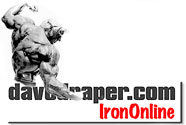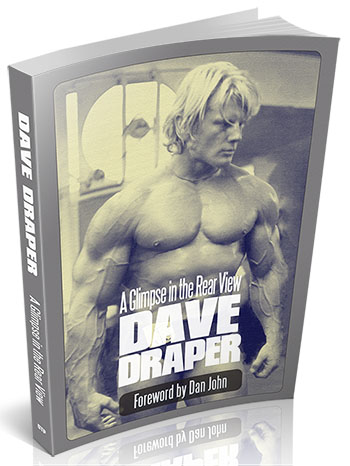Shoulder Injuries and Rotator Cuff Repair
Rotator Cuff Problems in Weight Lifters
A popular request made by cheerful muscle enthusiasts is for a shoulder routine that will build might, width and rounded muscularity. Another question, the flip side of the first and as common, is how do I approach and repair a shoulder that is injured, painful and limited. The latter, asked by grim-faced vets and innocents, is this week's subject. In the next weeks we'll consider the shoulders' brawn and girth.
The shoulders are a major trouble spot, taking abuse at every turn. We overload them as we work the biceps, triceps, chest, lats, lower back and legs. They have no place to hide. Throw a ball, shoot a basket, tackle a speeding body, take a nosedive over the handlebars and the shoulders are there being pounded, wrenched, rotated and separated.
A spill off a hillside some years ago busted my clavicle and completely tore a supra-spinatus, putting me in a cast with my right arm 90 degrees out to the side, supported by a preposterous inflated balloon. Lousy way to spend the summer. Surgery was 6 hours, recovery continues to this day. The doc — the best — said, "You do the rehab. I don't want anybody tearing out the stitches." Thanks. This is what I did:
One week after surgery I was back in the gym, cast, balloon, sling, Velcro straps, zippers — and what all. Twenty minutes on the LifeCycle was no problem. Crunches and leg raises required some improvising, movement abbreviation, but where there's a will, there's a way. Fine. From there, the first day I did my legs: extensions, curls, heavy leg presses, seated calves. It all worked well. I quickly became familiar with the regional pain and managed to isolate it.
Days two and three, upper body days, things got, um, silly, absurd, frustrating and gruesome. But that didn't stop me, I'm an elevator whose cables have been cut, ready or not, I'm comin' down. I continued my training in keeping with my developing theory to maintain body symmetry by working everything but that which was not workable. I started with light weights, left side only. I used substantial body rhythm to involve as much torso and relative muscles without excessive contraction of the muscles directly under repair. I imagined — visualized — my right side being involved. I began to feel my way around, extending my isotonic and isometric contractions to the injury perimeter. Very critical process. Wide grip pulldowns were immediately eliminated. Duh. Initially the slightest contraction was painful (good signal) and could undo what the master had skillfully reconstructed. But, hey, I'm fighting for me life here, fans of the underdog, and I have the brains of a flea.
To make a long story short, and not to further expose my neurotic obsessive behavior (NOB), in two months the cast was removed, the balloon deflated and I was on my own. The lopsided training I'm convinced helped me maintain mass, balance and total circulation. It certainly kept me occupied and hopeful, and reasonable sane. My training was never halted, only compromised. It enabled me to begin my rotation cuff rehabilitation with a headstart and confidence.
The advice I offer is always qualified by the sentiment, if not the statement, "This is what I would do if I were you." Last week's point was — work through it all and you'll heal sooner. Why? Food for thought, my guesses...
Systemic response
Anabolic and anti-catabolic properties of circulation
Healing nutrients and oxygen supplied by the blood
Detoxification
Endorphin and hormone production
Tender loving care factor
Psychology of proactive, positive steps toward recovery
Goals — motivation stimulus
Maintenance of attitude
Stemming of stress and submission
Social interaction keeping you engaged, involved, fulfilled, directed and attuned
You're doin' it
Seriously, unless you have a concussion, you're bleeding or beyond reasonable mobility, there are no excuses, are there?
Okay. The cast is off, sling nearby in the gym bag like a security blanket. You feel naked, vulnerable and not the slighted bit curious about the degree of movement your misbehaving shoulder conceals. What's the rush?
The first thing I did was find the most private corner of the gym so it was me only. Selfish, undistracted, unself-conscious, focused. I supported my injured right shoulder by holding it at the elbow, bent forward at the waist as if preparing to do a dumbbell row and slowly lowered the arm so it hung there by its own weight. Amazing — I imagined the internal stitching and reconstruction to be delicate and the shoulder not yet ready to be released from its nest. 30 seconds of hanging with a small circular motion the size of a plate and it began to throb — 1 set down, 4 to go. Enough for one day.
Within a week I progressed from a 5 pound plate to a ten pound dumbbell and was doing five sets of 25, clockwise and counter clockwise circles: gravity and me in full sight of wiseguy gym members offering me a spot if I needed it. Each evening at home I stood before a stucco wall, placed my hand against the textured finish and used my fingers to walk my hand up the wall much like the movement of a disturbed caterpillar bound for the ceiling. Tough stuff. Your main focus is to get movement and range of motion as soon as possible, and prevent scar tissue from limiting your shoulder rotation without damaging it. You wonder where the fine line between healthy therapy and damage resides. Pain is the moderator. 5 sets of finger walking as high as you can go — higher, higher still, knocks you out. Instinct, intelligence, caution and risk are the balls you juggle like a frowning circus clown.
Now I grab a broomstick, over grip as if ready to reverse curl and with stiff arms raise the bar before me, my strong arm leading and assisting in the action. I start and complete the movement with broomstick parallel to the floor. Another four sets of 8-10 reps is sufficient, each successive set giving me greater height. It's a long time before I'm standing with arms straight overhead. Three weeks and it's getting easier, more volume of reps, more aggressive, more determined and the pain a factor defined, accepted and understood. No longer an enemy, diminishing now.
The first major exercise I'm able to perform is the famous inner and outer rotation with a rubber band or exertube. You know the drill, you stand rigid with your arm by your side, bent at the elbow and rotate your hand in toward the body and alternately rotate your hand away from the body. (4 sets of 25 reps - both left and right) Five years ago this exercise combination was seldom witnessed at World Gym and was considered for saps only.
Today we have a dozen multicolored tubes of various tensions being pumped in every corner of the gym giving it the appearance of an amusement park. This movement is serious, deserves focus and one hundred percent effort. It does wonders to develop the minor rotation cuff muscles and tendons that stabilize the shoulder and provide resistance and muscle fullness. The usual presses and laterals don't effect the shoulder straps and require their loyal and tenacious support to help you blast away. Delts need to be warmed up and treated kindly. Do these cuff rotations regularly to maintain health and achieve full deltoid potential. I dare 'ya.
The valley of injury recedes as I climb the foothills towards the summit. I'm now prepared for an empty bar and small dumbbells and the first steps of real weight lifting. Here I recollect and I begin as a beginner. Humbling. God's speed.
Here's part two of Dave's rotator cuff rehab.
Did you already see the page on training injuries?
Click here for more on squatting with shoulder problems
Here Dave discusses his bout with tendonitus
Can I tell you a little more about protein powders?
For more on food supplementation, visit this page.
May we answer any bodybuilding questions for you in our forum?
If you haven't yet read Dave's bodybuilding book, Brother Iron, Sister Steel, here's more information.
You may also enjoy our ongoing weight training and fitness article blog, which we update with new material several times each week.
Are you in the mood for reading an weight training book excerpt?
Could you use a new 8-week workout routine or a bodypart workout program? Need to learn how to squat or how to deadlift?
Or select a link to the right to discover our most popular pages that are sure to answer all your training questions.

